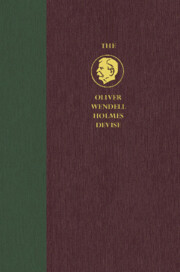Book contents
- The Hughes Court
- The Oliver Wendell Holmes Devise History of the Supreme Court of the United States
- Additional material
- Additional material
- The Hughes Court
- Copyright page
- Contents
- Acknowledgments
- Preface
- Table of Cases
- Introduction
- Part I The Opening Years
- Part II Continuities
- Part III New Approaches Begin to Emerge
- Section A: Economics
- Section B: Civil Liberties after 1937
- Chapter 39 The Justices and the Theories
- Chapter 40 Demonstrations, Picketing, and First Amendment Theories
- Chapter 41 The Jehovah’s Witnesses and First Amendment Theories
- Chapter 42 Conclusion
- Historiographical Essay
- Index
Chapter 41 - The Jehovah’s Witnesses and First Amendment Theories
from Section B: Civil Liberties after 1937
Published online by Cambridge University Press: 13 January 2022
- The Hughes Court
- The Oliver Wendell Holmes Devise History of the Supreme Court of the United States
- Additional material
- Additional material
- The Hughes Court
- Copyright page
- Contents
- Acknowledgments
- Preface
- Table of Cases
- Introduction
- Part I The Opening Years
- Part II Continuities
- Part III New Approaches Begin to Emerge
- Section A: Economics
- Section B: Civil Liberties after 1937
- Chapter 39 The Justices and the Theories
- Chapter 40 Demonstrations, Picketing, and First Amendment Theories
- Chapter 41 The Jehovah’s Witnesses and First Amendment Theories
- Chapter 42 Conclusion
- Historiographical Essay
- Index
Summary
The Jehovah’s Witnesses were regular litigants in the Hughes Court because they entirely denied the authority of government over their religious activities, and because their activiites routinely provoked intense controversy where they tried to proselytize. Their record in the Supreme Court was mixed, though overall they probably came out of the Supreme Court in a better position than they had been in before. But, in the Court’s most important decision dealing with the sect, the Court upheld controversial programs requiring that all students salute the US flag, including students who had religious objections to the practice. That decision, strongly criticized from the moment it was handed down, was soon repudiated, though only after Hughes had retired.
- Type
- Chapter
- Information
- The Hughes CourtFrom Progressivism to Pluralism, 1930 to 1941, pp. 1116 - 1141Publisher: Cambridge University PressPrint publication year: 2022

